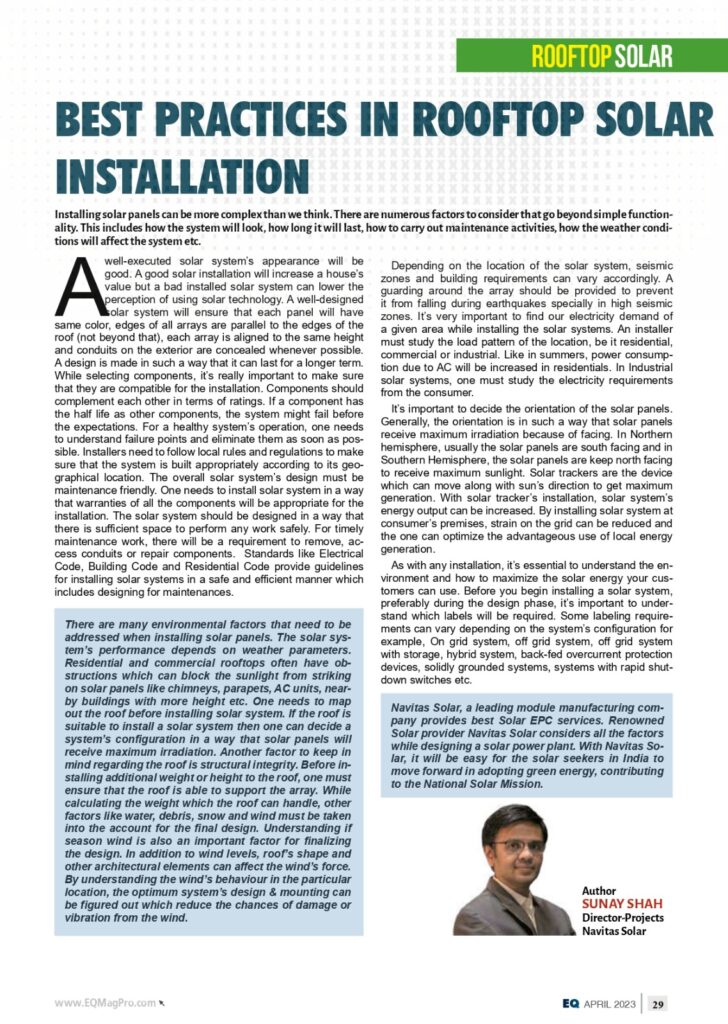Sunay Shah’s EQ International Feature: Rooftop Solar Best Practices

Installing solar panels can be more complex than we think. There are numerous factors to consider that go beyond simple functionality. This includes how the system will look, how long it will last, how to carry out maintenance activities, how the weather conditions will affect the system etc.
A well-executed solar system’s appearance will be good. A good solar installation will increase a house’s value but a bad installed solar system can lower the perception of using solar technology. A well-designed solar system will ensure that each panel will have same color, edges of all arrays are parallel to the edges of the roof (not beyond that), each array is aligned to the same height and conduits on the exterior are concealed whenever possible. A design is made in such a way that it can last for a longer term.
While selecting components, it’s really important to make sure that they are compatible for the installation. Components should complement each other in terms of ratings. If a component has the half life as other components, the system might fail before the expectations. For a healthy system’s operation, one needs to understand failure points and eliminate them as soon as possible. Installers need to follow local rules and regulations to make sure that the system is built appropriately according to its geographical location. The overall solar system’s design must be maintenance friendly. One needs to install solar system in a way that warranties of all the components will be appropriate for the installation. The solar system should be designed in a way that there is sufficient space to perform any work safely. For timely maintenance work, there will be a requirement to remove, access conduits or repair components. Standards like Electrical Code, Building Code and Residential Code provide guidelines for installing solar systems in a safe and efficient manner which includes designing for maintenances.
There are many environmental factors that need to be addressed when installing solar panels. The solar system’s performance depends on weather parameters. Residential and commercial rooftops often have obstructions which can block the sunlight from striking on solar panels like chimneys, parapets, AC units, nearby buildings with more height etc. One needs to map out the roof before installing solar system. If the roof is suitable to install a solar system then one can decide a system’s configuration in a way that solar panels will receive maximum irradiation. Another factor to keep in mind regarding the roof is structural integrity.
Before installing additional weight or height to the roof, one must ensure that the roof is able to support the array. While calculating the weight which the roof can handle, other factors like water, debris, snow and wind must be taken into the account for the final design. Understanding if season wind is also an important factor for finalizing the design. In addition to wind levels, roof’s shape and other architectural elements can affect the wind’s force. By understanding the wind’s behavior in the particular location, the optimum system’s design & mounting can be figured out which reduce the chances of damage or vibration from the wind.
Depending on the location of the solar system, seismic zones and building requirements can vary accordingly. A guarding around the array should be provided to prevent it from falling during earthquakes specially in high seismic zones. It’s very important to find our electricity demand of a given area while installing the solar systems. An installer must study the load pattern of the location, be it residential, commercial or industrial. Like in summers, power consumption due to AC will be increased in residentials. In Industrial solar systems, one must study the electricity requirements from the consumer.
It’s important to decide the orientation of the solar panels. Generally, the orientation is in such a way that solar panels receive maximum irradiation because of facing. In Northern hemisphere, usually the solar panels are south facing and in Southern Hemisphere, the solar panels are keep north facing to receive maximum sunlight. Solar trackers are the device which can move along with sun’s direction to get maximum generation. With solar tracker’s installation, solar system’s energy output can be increased. By installing solar system at consumer’s premises, strain on the grid can be reduced and the one can optimize the advantageous use of local energy generation.
As with any installation, it’s essential to understand the environment and how to maximize the solar energy your customers can use. Before you begin installing a solar system, preferably during the design phase, it’s important to understand which labels will be required. Some labeling requirements can vary depending on the system’s configuration for example, On grid system, off grid system, off grid system with storage, hybrid system, back-fed overcurrent protection devices, solidly grounded systems, systems with rapid shutdown switches etc.
Navitas Solar, a leading module manufacturing company provides best Solar EPC services. Renowned Solar provider Navitas Solar considers all the factors while designing a solar power plant. With Navitas Solar, it will be easy for the solar seekers in India to move forward in adopting green energy, contributing to the National Solar Mission.


 Online | Privacy policy
Online | Privacy policy
Related Posts
You May Also Like
Bonito Series: Driving Innovation in…
Read MoreTOPCon Series: The Next Generation…
Read MoreValuable Points to Remember During…
Read MoreNavitas Planet Partners with Hysolwin…
Read MoreDriving Towards a Sustainable Future:…
Read MoreWhy Do Top-Grade EVA Sheets…
Read MoreBonito Series: Driving Innovation in…
Read MoreTOPCon Series: The Next Generation…
Read MoreValuable Points to Remember During…
Read MoreNavitas Planet Partners with Hysolwin…
Read MoreDriving Towards a Sustainable Future:…
Read MoreWhy Do Top-Grade EVA Sheets…
Read MoreBonito Series: Driving Innovation in…
Read MoreTOPCon Series: The Next Generation…
Read MoreValuable Points to Remember During…
Read MoreNavitas Planet Partners with Hysolwin…
Read More